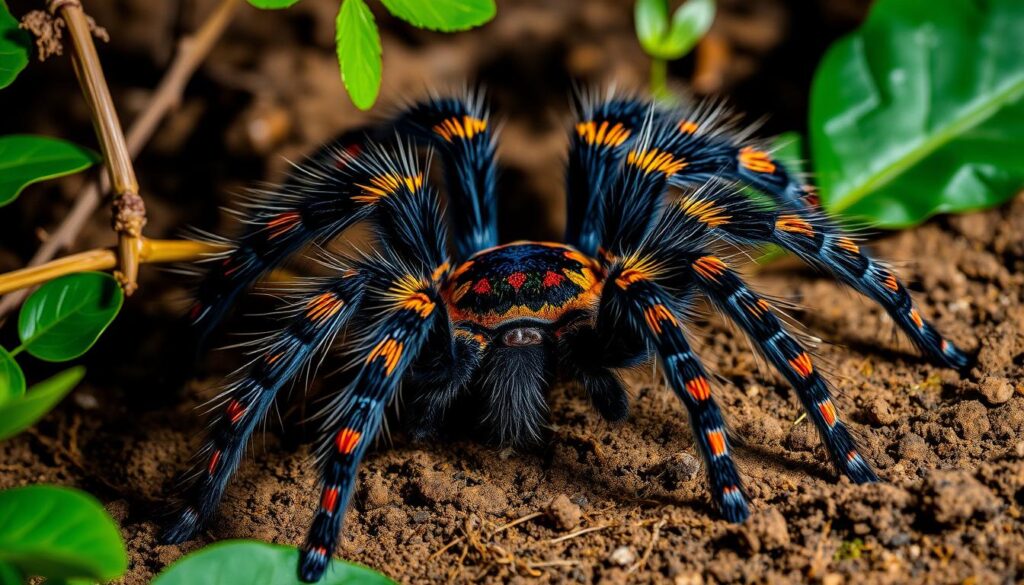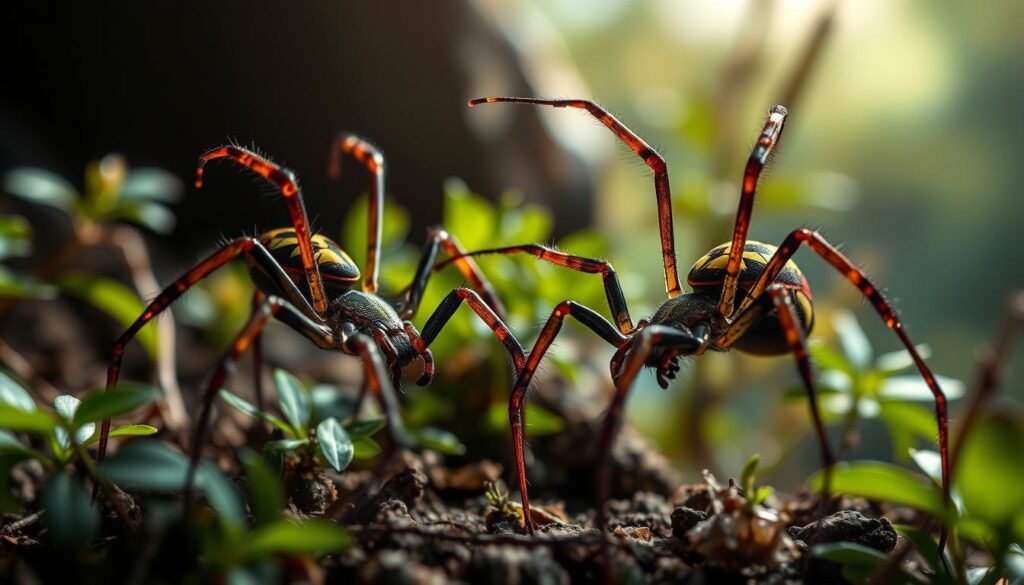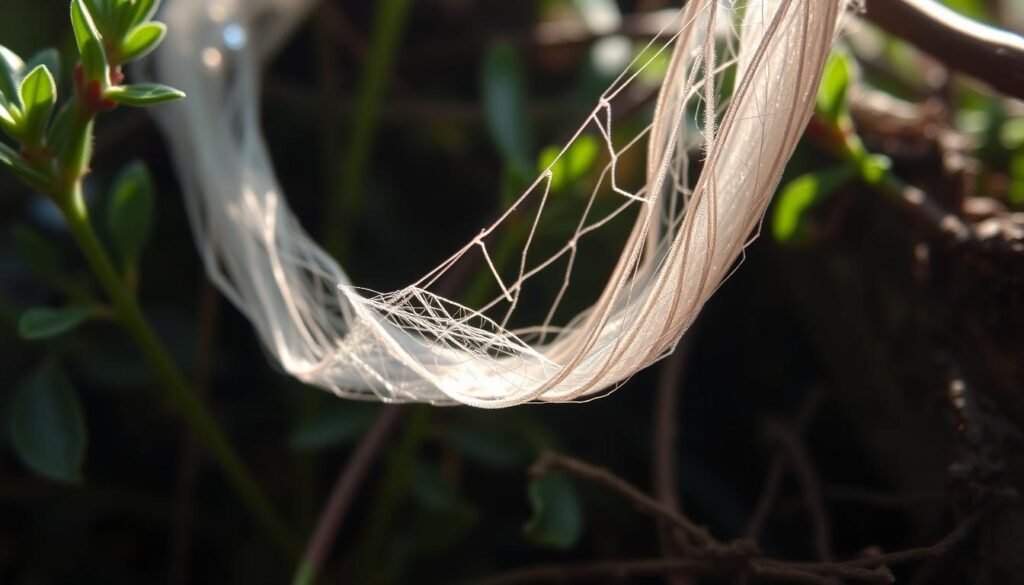Discover the Fascinating World of Theraphosidae

Get ready to explore the world of tarantulas. These mysterious arachnids have fascinated many for years. Theraphosidae, the tarantula family, is full of unique features and behaviors.
We’ll dive into their scientific details, physical traits, and how they live. You’ll learn about their diet, how they reproduce, and their connection with humans.
The Theraphosidae family includes the huge Goliath birdeater and the tiny dwarf tarantulas. This guide is for both experts and beginners. It aims to deepen your understanding and love for these creatures.
Join us as we uncover the secrets of the Theraphosidae. Discover their role in our world.
Introduction to Tarantulas
Tarantulas are a group of spiders that belong to the Theraphosidae family. They have long fascinated scientists, nature lovers, and adventurers. These spiders are known for their large size, hairy bodies, and unique behaviors.
There are over 900 recognized species of tarantulas. They can grow quite large, with some species reaching up to 10 cm (4 inches) in body length. Their leg span can be up to 30 cm (12 inches). They also live a long time, up to 30 years in captivity.
Many people think tarantulas are venomous, but their venom is not as dangerous as some other spiders. Instead, they have a special defense. They can flick their urticating hairs at predators, causing irritation.
Tarantulas have strong legs that help them support their weight and burrow into the earth. They also have a slow growth rate and go through many molting stages. This makes them even more fascinating.

Exploring the world of Theraphosidae reveals many interesting facts and behaviors. Tarantulas are amazing creatures that continue to inspire and captivate those who love nature.
Scientific Classification of Theraphosidae
The Theraphosidae family, also known as tarantulas, is part of the Mygalomorphae suborder. This group is one of the oldest spider families. It has over 1,100 species spread across many genera. This makes it a key part of arachnid taxonomy.
Taxonomic Ranks
Theraphosidae falls under the Mygalomorphae suborder. This suborder has about 3,000 valid species in 31 families. Within Theraphosidae, there are 13 living subfamilies. These include Aviculariinae, Eumenophorinae, and Harpactirinae. There’s also one extinct subfamily, Prototheraphosinae.
Genera and Species Distribution
Theraphosidae has over 1,100 valid species. This makes up more than a third of mygalomorph diversity. Tarantulas from this family are found on continents like North America, South America, Europe, Africa, Asia, and Australia. Their wide distribution shows how common they are.
| Continent | Number of Theraphosidae Species |
|---|---|
| North America | 150+ |
| South America | 650+ |
| Europe | 20+ |
| Africa | 100+ |
| Asia | 200+ |
| Australia | 50+ |
Research and molecular phylogenies have helped us understand the Theraphosidae family better. They have challenged old ideas and made taxonomic relationships clearer.

Distinctive Physical Traits
Tarantulas, part of the Theraphosidae family, are known for their strong and hairy bodies. They vary in size, with some having leg spans up to 10 inches (25 cm). Their bodies are made of a cephalothorax (head and thorax combined) and an abdomen. They also have eight legs and two pedipalps for sensing and catching prey.
Their coloration is also striking, ranging from earthy tones to bright blues, greens, and oranges. This color variety helps them blend in, signal, and regulate their body temperature.
Body Structure and Appearance
Theraphosidae spiders, or tarantulas, have sturdy and hairy bodies. They have a clear cephalothorax and abdomen. They also have eight legs and pedipalps for sensing and catching prey.
Size and Coloration Variations
Tarantulas come in many sizes, with some having leg spans up to 10 inches (25 cm). Their coloration is diverse, from earthy tones to bright colors. These colors help them hide, signal, and control their body temperature.

Habitats and Geographical Distribution
Tarantulas, part of the Theraphosidae family, live in many places. They are found in tropical rainforests and deserts. They are spread across the world, including North and South America, Africa, and Southeast Asia. Their homes are perfect for burrowing and hiding.
Preferred Environments
Theraphosidae, or tarantulas, live in many environments. They need places with resources and safety. In the southwestern United States, Mexico, and tropical America, some tarantulas can grow big. For example, Aphonopelma californicum can be up to 5 cm long and 12.5 cm wide.
 Discover Spiders in Australia: Your Arachnid Guide
Discover Spiders in Australia: Your Arachnid Guide
In South America, the biggest tarantulas are in the genus Theraphosa. The goliath bird-eating spider can be up to 7.5 cm long. The pinkfoot goliath and the goliath bird-eating spider can have leg spans of about 30 cm.
| Tarantula Species | Habitat | Size |
|---|---|---|
| Aphonopelma californicum | Southwestern United States, Texas, Arizona | Body length: up to 5 cm, Leg span: up to 12.5 cm |
| Theraphosa leblondi (Goliath bird-eating spider) | South America | Body length: up to 7.5 cm, Leg span: up to 30 cm |
| Theraphosa apophysis (Pinkfoot goliath) | South America | Leg span: up to 30 cm |
New World tarantulas live in the Americas. Old World tarantulas are in Africa and Southeast Asia. They live in forests and deserts, showing how well they adapt.

Intriguing Behaviors
Tarantulas, part of the Theraphosidae family, are truly fascinating. They have behaviors that amaze people all over the world. These spiders are mostly alone and active at night. They are known for their amazing burrowing and climbing abilities, and how they defend themselves.
Burrowing and Climbing Abilities
Many terrestrial tarantula species are great at digging. They create complex tunnels and burrows as their homes. These underground places protect them from predators and harsh weather. They are also perfect for hunting and breeding.
On the other hand, arboreal tarantulas are excellent climbers. They live in the branches and crevices of trees.
Defensive Mechanisms
When tarantulas feel threatened, they use different ways to defend themselves. One famous way is when they rear up on their hind legs. This makes them look bigger and scarier. Some tarantulas also have urticating hairs that they can shoot at predators. These hairs can make the aggressor feel uncomfortable and irritated.
| Behavior | Description |
|---|---|
| Burrowing | Terrestrial tarantulas excavate intricate tunnels and burrows as their homes. |
| Climbing | Arboreal tarantulas are skilled climbers, often making their homes in trees and branches. |
| Defensive Posturing | Tarantulas can rear up on their hind legs to appear larger and more intimidating to potential predators. |
| Urticating Hairs | Some tarantula species possess irritating hairs that they can project towards aggressors. |

Dietary Habits and Hunting Strategies
Tarantulas are carnivorous predators that use stealth and ambush tactics to catch their prey. They mainly eat insects like crickets, beetles, grasshoppers, and cockroaches. But they also hunt small vertebrates such as frogs, lizards, mice, and even small birds.
To subdue their prey, tarantulas use their potent venom. This venom liquefies the internal tissues, making it easier for them to eat. With sharp fangs and powerful jaws, they tear apart their prey and enjoy their meals.
The Theraphosidae family includes many tarantula species, each with unique hunting strategies and diets. For example, the Goliath birdeater (Theraphosa blondi) is the largest tarantula by mass. It can live up to 25 years, while males live only 3-6 years after they mature.
Other interesting examples include the Mexican redknee tarantula (Brachypelma smithi) and the Costa Rican zebra tarantula (Aphonopelma seemanni). The Mexican redknee tarantula can live up to 30 years and mainly eats insects. The Costa Rican zebra tarantula can live over 20 years and eats a variety of insects and small vertebrates.

Tarantulas are fascinating in their dietary habits and hunting strategies. They use their keen senses, including multiple eyes and sensitive leg hairs, to detect prey. This allows them to ambush their targets with quick strikes.
Theraphosidae Reproduction
The process of Theraphosidae reproduction, or tarantula mating, is fascinating. Male tarantulas mature faster than females. Sadly, many males don’t make it through the mating ritual.
Mating Rituals
The ritual starts with the male making a silk “sperm web.” He then shows off to the female with his legs and pedipalps. If she’s interested, he transfers his sperm to her.
Egg Sacs and Spiderling Development
After mating, the female tarantula lays 50 to over 1,000 tarantula eggs in a silk sac. She protects the sac fiercely. The eggs hatch in six to eight weeks.
The tiny tarantula spiderlings then leave the burrow to start their tarantula life cycle.

The Theraphosidae reproduction process shows the amazing adaptations of these arachnids. From the complex mating rituals to the care of the egg sacs, it’s a wonder of nature.
Natural Predators and Threats
Tarantulas, part of the Theraphosidae family, face many dangers. One big threat is the tarantula hawk wasp. This wasp can paralyze a tarantula and lay its eggs on the spider’s body. Birds and small mammals like owls, coatis, and possums also hunt them.
But humans are a bigger danger to tarantulas. Habitat destruction and the exotic pet trade harm them. As land is cleared, tarantulas lose their homes. The demand for them as pets also leads to their capture from the wild.
 Tarantula Babies on Back: What You Need to Know
Tarantula Babies on Back: What You Need to Know
Despite these dangers, efforts are being made to save tarantulas. Some species, like the Mexican red-knee tarantula, are protected by laws. This helps control their capture and protect their homes. By learning about the dangers tarantulas face, we can help keep them safe.
| Predator | Impact on Tarantulas |
|---|---|
| Tarantula hawk wasp | Paralyzes and lays eggs on tarantulas, providing food source for its larvae |
| Birds and small mammals | Prey on tarantulas, including owls, coatis, and possums |
| Humans | Habitat destruction and capture for the exotic pet trade |

By understanding the dangers tarantulas face, we can help protect them. This includes efforts in tarantula conservation.
Conservation Status and Challenges
The conservation of Theraphosidae, or tarantulas, has both good and bad news. Most tarantulas are not endangered, but they face big threats. We need to pay attention and take action.
Habitat loss is a major challenge for tarantula conservation. Human activities like deforestation and urban growth harm their homes. These changes reduce the places where tarantulas can live.
The exotic pet trade also poses a threat. People’s desire to have these unique animals leads to over-hunting. For example, the Mexican red-knee tarantula (Brachypelma smithi) is now protected to stop its over-hunting.
- Approximately 450 Theraphosidae toxin sequences were available, of which 337 were considered for screening.
- Only 20 toxin sequences were chosen based on their similarity to known anti-cancer peptide sequences.
- Molecular docking studies revealed promising interactions between Theraphosidae toxins and death receptors, suggesting potential therapeutic applications.
Despite these challenges, efforts are being made to save Theraphosidae species. Projects like habitat restoration and captive breeding help. Education campaigns also raise awareness. Together, we can protect these amazing creatures for the future.

Fascinating Facts About Tarantulas
Step into the captivating world of Theraphosidae, the family of spiders known as tarantulas. They have traits that amaze scientists and fans. Learn about their silk, defense, and long life.
Silk Production
Tarantulas don’t spin webs like others, but they use silk. They line burrows, make egg sacs, and trapdoors with it. Their silk shows their clever engineering.
Urticating Hairs
New World tarantulas have a special defense: urticating hairs. These hairs on their bellies can be released to scare off predators. They cause a painful itch, keeping predators away.
Longevity
Tarantulas live long, especially females. Female tarantulas can live up to 30 years. Males live a few years after they can mate. Their long life shows their strength and adaptability.
The Theraphosidae family of tarantulas is fascinating. They amaze with their silk, defense, and long life. Exploring these facts reveals a world of wonder and respect for these amazing tarantulas.

Evolutionary History of Mygalomorphae
The world of tarantulas, or Theraphosidae, is deeply connected to the Mygalomorphae suborder’s history. These spiders have been around for over 300 million years. Before the common araneomorph spiders, they adapted to different environments, spreading across the globe.
Spiders are incredibly diverse, with over 51,000 species. Their venom is complex, containing many different components. It’s believed that up to 10 million biomolecules could be found in spider venom.
Most spider venom toxins are small peptides with a unique structure. These toxins are being studied for treating diseases like epilepsy and chronic pain. Yet, there are also high-molecular-weight proteins in spider venom that are still unexplored.
The Mygalomorphae and Theraphosidae’s history shows their resilience and adaptability. Studying their venom and physiology gives us insights into their evolution. This knowledge helps us understand the spider evolution and the Theraphosidae evolution that has made them so diverse.
| Key Facts | Value |
|---|---|
| Number of described spider species | Over 51,000 |
| Number of potential biomolecules in spider venoms | Up to 10 million |
| Number of known spider venom toxins with ICK motif | Most known venom toxins |
| Number of valid Theraphosidae species | Over 1,100 |
| Number of extant Theraphosidae subfamilies | 13 |
| Number of extinct Theraphosidae subfamilies | 1 |
The Mygalomorphae evolution and arachnid evolution that led to the Theraphosidae family are fascinating. As we learn more about these creatures, we gain new insights into spider evolution. These discoveries help us understand the natural world and its intricate connections.

Relationship with Humans
Theraphosidae, or tarantulas, have long fascinated humans. They are both admired and feared for their size and venom. Though their bites are rarely deadly, their appearance can make people nervous.
However, tarantulas have also won the hearts of exotic pet lovers. Their interesting behaviors and beautiful colors make them great pets. The pet trade has helped raise awareness about these amazing spiders, especially for endangered species.
 Tarántulas Venenosas ¿Son Realmente Peligrosas?
Tarántulas Venenosas ¿Son Realmente Peligrosas?
Tarantulas also play a role in the traditions of some indigenous communities. They are used in medicine and rituals. As we learn more about tarantulas, our connection with them will grow. This will help us appreciate their place in nature even more.



